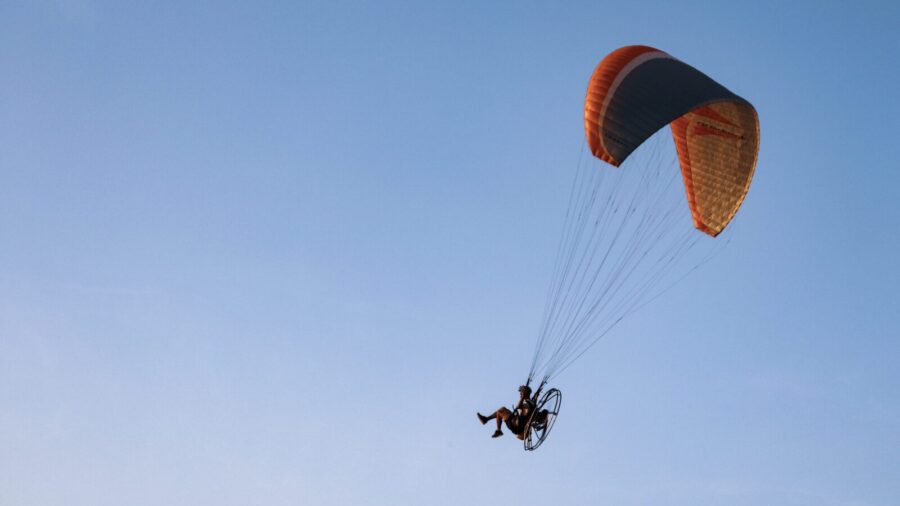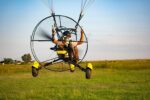What Happens If a Paramotor Runs Out of Fuel? A Pilot’s Guide
18 September 2023 | Updated on November 05, 2024
For many aspiring and seasoned pilots, the allure of paramotoring lies in its simplicity and the unparalleled sense of freedom it offers. With the wind in your hair and the world beneath your feet, it’s easy to get lost in the moment and forget about mundane concerns – like the fuel gauge. But what happens if a paramotor runs out of gas mid-flight? While this might sound like a nightmare scenario, understanding the mechanics and how to respond can make all the difference.
Whether you’re a curious onlooker, a beginner pilot, or even a seasoned flier seeking a refresher, this guide aims to address that pressing question. We’ll break down the consequences of running out of fuel during a paramotor flight, and offer safety tips and procedures to help you handle such situations confidently.


A paraglider prepares to fly over the desert in Dubai.
Important Disclaimer: The information and data provided here are for informational purposes only, and are subject to change over time. We strive to provide the most current and relevant information, but the dynamic nature of the topics discussed may result in changes that are not immediately reflected in our content. We recommend our readers to conduct their own research and consult with professionals when making significant decisions based on the data or information provided here. Your reliance on the information in this post is solely at your own risk.


Understanding the Basics of a Paramotor
A paramotor, often referred to as powered paragliding, is a unique aviation marvel. At its core, a paramotor is essentially a paraglider with a motor attached. It consists of a motor-driven propeller worn on the pilot’s back, providing thrust, and a paraglider wing that offers lift. This combination enables pilots to launch from flat ground and fly with the freedom that few other aircraft can match. The beauty of a paramotor is in its simplicity: there’s no need for long runways, control towers, or intricate flight systems. The sky, quite literally, is the limit.
When it comes to fuel consumption, much depends on the type of engine, the weight of the pilot, the flying conditions, and the throttle use during flight. On average, a paramotor can consume anywhere from 2 to 4 liters (0.5 to 1 gallon) of fuel per hour, granting pilots several hours of airtime with a standard tank. This duration, of course, can vary, and it’s essential to always overestimate your fuel needs rather than underestimate.
Remember, in aviation, it’s always better to be on the ground wishing you were in the sky than in the sky wishing you were on the ground!
What Happens When a Paramotor Runs Out of Fuel?
The very mention of running out of fuel mid-air can evoke a sense of panic and images of plummeting to the ground. However, in the world of paramotoring, the reality is quite different, and, thankfully, less dramatic. Understanding the following consequences can alleviate some of those initial fears.
Firstly, it’s essential to clarify a common misconception: paramotors don’t “fall” out of the sky when they run out of gas. Instead, without engine power, a paramotor simply becomes a paraglider. This means the pilot will continue to glide through the air, using the wing’s aerodynamic properties. The descent is gradual and controlled, giving pilots ample time to react and steer.


The role of the wing is crucial here. A paramotor’s wing is designed to catch and hold air, creating lift. Even in the absence of the motor’s thrust, the wing maintains this lift, allowing the pilot to glide downwards gracefully. This glide ratio, depending on the wing’s design and prevailing wind conditions, ensures that pilots can cover a reasonable distance horizontally while descending, increasing their options for safe landing spots.
In essence, running out of fuel during a paramotor flight doesn’t spell immediate disaster. Instead, it transitions the flight mode, demanding quick thinking, and a calm approach from the pilot. The sky doesn’t suddenly become a hostile environment; it just necessitates a change in strategy.
Safety Protocols and Procedures
In the event of a fuel outage during a paramotor flight, preparedness is everything. Being equipped with knowledge and having practiced procedures can turn a potentially stressful situation into a manageable one.
Let’s delve into the safety protocols that every paramotorist should have in their toolkit:
- Regular altitude checks: One of the primary defenses against unexpected fuel outages is maintaining a safe altitude. Regularly monitoring your altitude gives you a buffer, ensuring that you have sufficient time and space to react and plan your descent. The higher you are, the more options you have in choosing a landing spot.
- Identifying landing zones in advance: Always be on the lookout for potential landing zones throughout your flight. Familiarize yourself with the terrain below, spotting open fields, clearings, or other safe areas to touch down. It’s wise to mark these zones mentally or even on a map or flight app if available. In case of a fuel outage, having these zones pre-identified can save precious time and reduce panic.
- Techniques for safe and controlled descent: Once you realize you’ve run out of fuel, your priority shifts to managing your descent. It’s essential to:
- Stay calm: Panic can cloud judgment. Take deep breaths, assess the situation, and trust your training.
- Control speed: Use brake toggles judiciously to manage your speed and direction. Avoid sharp turns which can increase your descent rate.
- Approach and landing: As you near your chosen landing zone, prepare for landing by keeping your legs ready and slightly bent, flaring the wing to reduce speed, and touching down with a gentle run or walk.
By internalizing these procedures and practicing them regularly — even during normal flights — you’ll ensure that you’re always prepared, no matter what surprises your paramotor flight might present. Remember, safety in aviation isn’t just about avoiding risks; it’s about managing them effectively when they arise.


Tips to Prevent Running Out of Gas
While knowing how to respond to a fuel outage is invaluable, prevention remains the best strategy. Here are some tips to ensure you don’t find yourself without fuel during a paramotor flight:
- Monitoring your fuel: It might sound obvious, but regularly checking your fuel level can’t be overstated. Some paramotor setups come equipped with clear fuel tanks or fuel gauges, allowing for easy visual checks. For others, setting a timer or alarm based on estimated flight duration can serve as a reminder to gauge fuel levels.
- Estimating flight duration based on weather and flight conditions: Weather conditions, especially wind speed and direction, can dramatically impact fuel consumption. A flight against strong headwinds will burn fuel faster than one with tailwinds or in calm conditions. Before heading out, evaluate the day’s weather forecast and adjust your flight plan accordingly.
- Routine maintenance and checks for fuel system integrity: Regular maintenance of your paramotor not only ensures it’s running efficiently but can also highlight potential fuel system issues. Check for leaks, ensure fuel lines are clear, and confirm that the carburetor is functioning optimally. Periodic inspections and cleaning can prevent malfunctions that lead to increased fuel consumption.
- Plan fuel-conservative routes: When planning your flight path, consider routes that reduce the need for constant throttle adjustments or maneuvers, which can increase fuel consumption. Additionally, if you’re uncertain about fuel reserves, it’s wise to remain in proximity to familiar areas or known landing zones.
- Always carry a reserve: While it may add a bit of weight, carrying an emergency fuel reserve can be a lifesaver. Small collapsible fuel containers can provide that extra bit of range, allowing you to reach a safe landing spot or refueling station.
By following these preventative measures and always erring on the side of caution, you can significantly reduce the chances of ever having to deal with a fuel outage mid-flight. After all, a little preparation goes a long way in ensuring a safe and enjoyable paramotoring experience.
Conclusion
Running out of gas in a paramotor is undoubtedly a situation no pilot wishes to face. However, with a sound understanding of the equipment, environment, and safe landing procedures, it needn’t be a perilous scenario. Remember, the key lies in preparation, calm decision-making, and understanding that your paramotor is built to glide safely even without the engine’s thrust. Safe flying to all the adventurous souls out there!




























